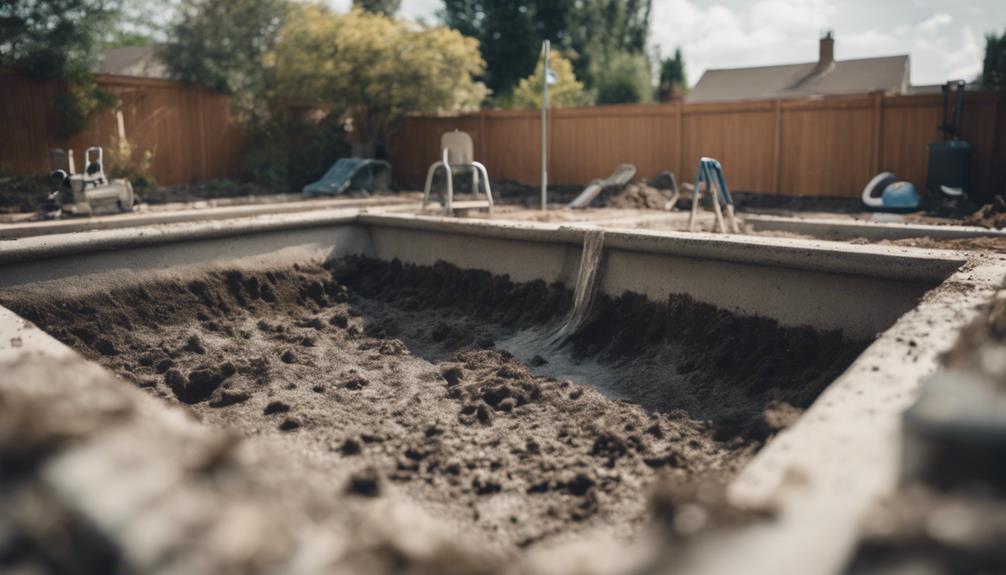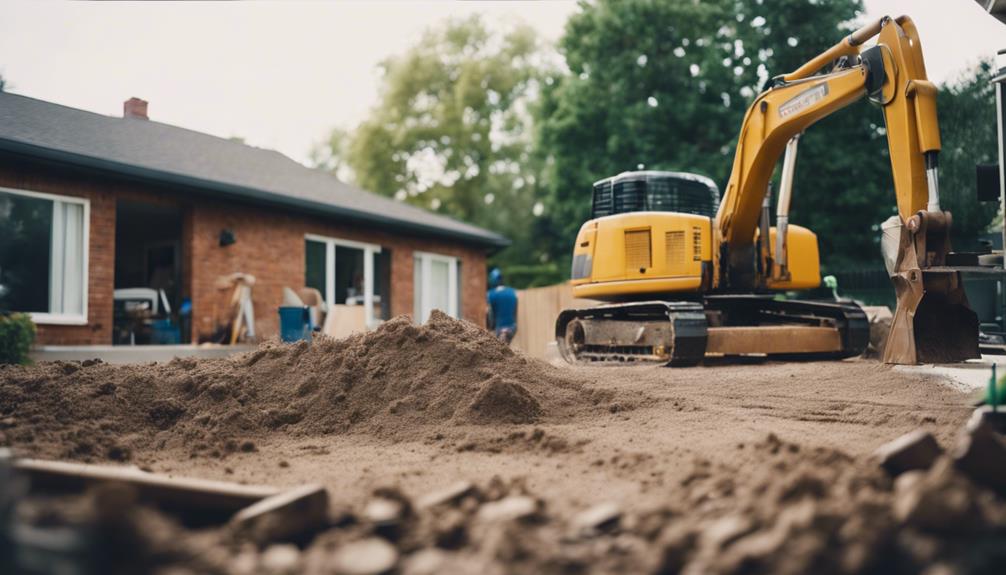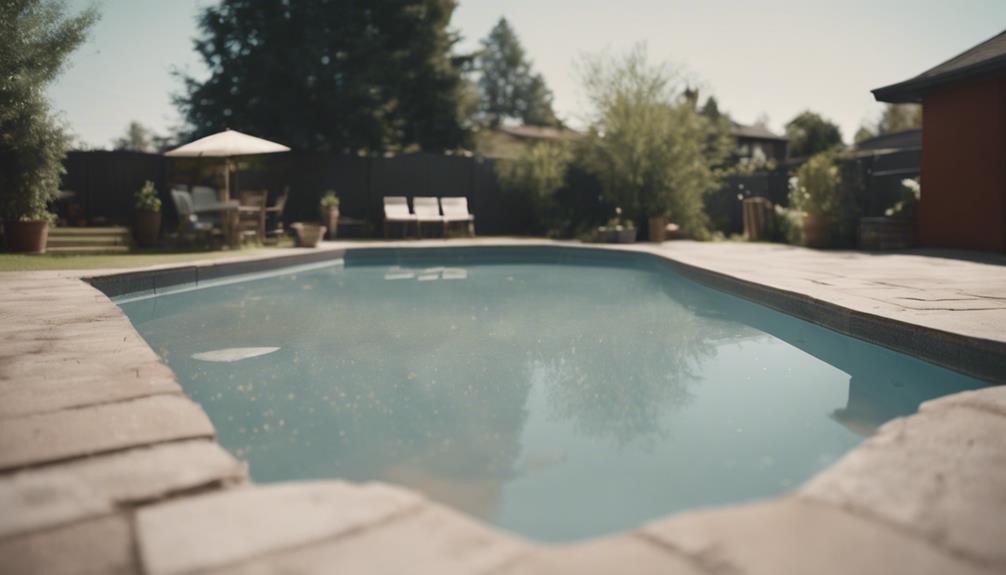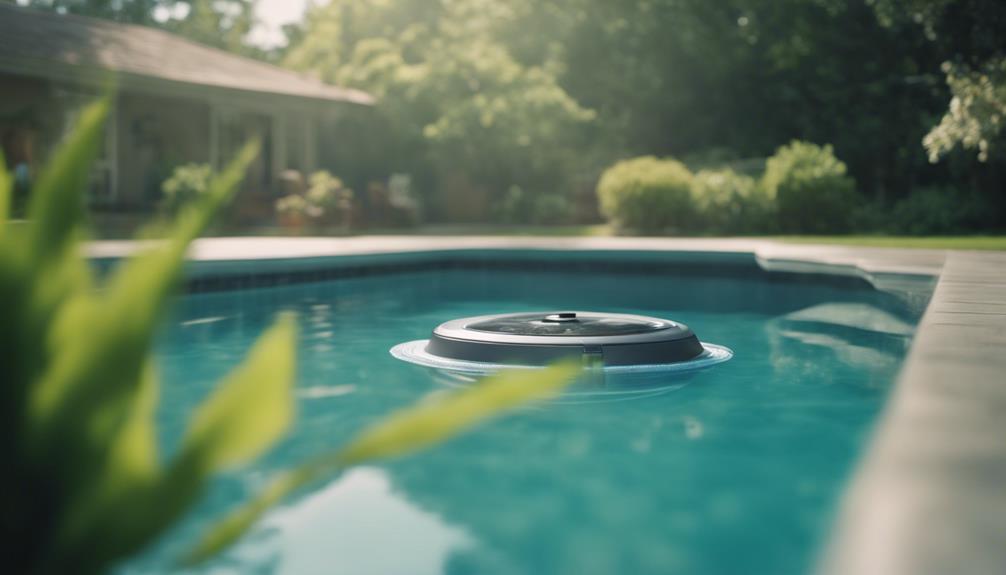To eliminate a swimming pool, there are options that include either partial or complete removal processes. Partial removal involves breaking down the top layer and then filling the pool with gravel or soil. Complete removal, on the other hand, includes draining the pool, demolishing it, backfilling the area, and disposing of the materials. It is crucial to obtain pool removal permits for compliance, and hiring efficient contractors is key. Another option to consider is converting the pool area into a deck or garden. It is important to carefully plan the landscaping after the pool removal process. Understanding these options is essential for making well-informed decisions. Additional information on removal methods, permits, contractors, conversion ideas, and landscaping considerations is available.
Key Takeaways
- Consider partial pool removal for future repurposing and landscaping opportunities.
- Complete removal involves draining, demolishing, backfilling, and proper disposal.
- Obtain necessary permits for compliance with regulations and zoning ordinances.
- Hire experienced pool removal contractors for efficient and compliant removal.
- Explore inground pool conversion ideas like decks, gardens, or fire pits for cost-effective alternatives.
Partial Pool Removal Process
If you're considering partial pool removal, the process typically involves breaking down the top layer of the pool and filling it with materials such as gravel or soil. This method, which is more important and quicker than complete removal, offers the advantage of future repurposing or landscaping of the pool area.
To guarantee the proper backfilling and compaction of the pool cavity, it's essential to hire experienced professionals. These experts can guide you through the process, avoiding potential issues and ensuring a smooth transformation of your pool space.
Complete Pool Removal Process

The complete pool removal process starts with draining the pool and then demolishing the structure using hydraulic breakers and pneumatic hammers. This demolition phase is critical in achieving a full pool removal. Once the pool is demolished, backfilling the cavity and compacting the soil are necessary steps to stabilize the ground. Responsible disposal of the pool materials is important to guarantee environmental safety. After the complete removal, following specific requirements for landscaping projects is essential to prepare the area for future construction. Below is a table summarizing key steps in the complete pool removal process:
| Key Steps | Description | Importance |
|---|---|---|
| Demolition | Using hydraulic breakers and pneumatic hammers to remove the pool | Essential |
| Backfilling | Filling the cavity left by the pool and compacting the soil | Stabilizing |
| Responsible Disposal | Ensuring proper disposal of pool materials | Environmental Safety |
| Landscaping | Meeting requirements for future landscaping projects | Preparation |
Pool Removal Permits

When removing a swimming pool, obtaining the necessary permits is crucial to guarantee compliance with regulations and proper disposal of the pool structure. Permit costs can vary depending on your location and municipality, covering the responsible removal of the pool structure.
Zoning ordinances may also play a role, dictating specific protocols for filling in the pool area after removal. It's advisable to hire a demolition contractor to assist in obtaining permits and managing the removal process efficiently.
These permits are essential to safeguard the safe and legal removal of a swimming pool, addressing potential environmental concerns such as proper disposal of materials and handling utility connections during the removal process.
Pool Removal Contractors

Consider reaching out to pool removal specialists for efficient and compliant removal of your swimming pool. Pool removal contractors can provide estimates for the cost and timeline of the removal project, guaranteeing compliance with local regulations and permits. Their expertise and equipment allow for a safe and efficient removal process.
From draining and demolition to backfilling and site restoration, pool removal contractors can manage the entire project seamlessly. It's advisable to obtain multiple quotes from different contractors to compare services and pricing.
Inground Pool Conversion Ideas

When considering the conversion of your inground pool, you may ponder whether to fill it or repurpose it into a functional space.
Exploring cost-effective alternatives can help you make an informed decision that aligns with your needs and budget.
Fill or Repurpose?
You can explore various inground pool conversion ideas, such as starting the space into a deck, garden, sunken fire pit, pond, or patio. Repurposing your pool area can add significant value and functionality to your property.
Converting an inground pool into a koi or wildlife pond offers a unique and visually appealing outdoor feature that can enhance the aesthetic appeal of your landscape. However, before starting on any pool conversion project, it's advisable to seek professional assistance. Professional help guarantees that repurposing projects are executed correctly, leading to long-term enjoyment of the transformed space.
When considering pool conversion options, it's essential to weigh the benefits and drawbacks of each. While repurposing can add value and enhance the visual appeal of your property, it may also require initial investment and ongoing maintenance.
Cost-Effective Alternatives
Converting an inground pool into a cost-effective and functional outdoor space can be achieved through a deck conversion offered by Deckover Pool Retirement. This pool removal method provides a budget-friendly option to transform the pool into a versatile outdoor living space.
Another creative way to repurpose the inground swimming pool is through partial removal and converting it into a koi or wildlife pond. This alternative not only saves costs but also adds a unique element to the backyard.
For those looking to create a beautiful garden space, transforming the pool area can be a cost-effective solution that enhances the aesthetic appeal of the outdoor area.
Additionally, for a sustainable and innovative approach, repurposing the pool into a sunken pit greenhouse offers a functional and eco-friendly alternative to traditional pool removal methods.
Opting for pool-to-deck conversions is another budget-friendly choice that covers the pool and provides an opportunity to create a new outdoor living space with multiple uses.
Post-Removal Landscaping Considerations

After removing a swimming pool, it's important to carefully consider landscaping options for the newly available space. Proper backfilling and soil compaction are essential to establish a stable foundation for future landscaping endeavors. Consulting with a landscaping professional can help in creating a detailed plan to make the most of the post-removal landscape.
It's vital to incorporate effective drainage solutions to prevent water accumulation in the former pool area and maintain the integrity of the landscaping over time. When selecting plants and features for the post-removal landscape, take into account the climate and soil conditions of your area to make sure that they thrive and contribute to the overall beauty and functionality of the space.
Whether opting for sod replacement, tree planting, or deck installation, choosing the right landscaping elements won't only enhance the aesthetics but also add value to your property. By paying attention to these post-removal landscaping considerations, you can transform your former pool area into a stunning outdoor space that suits your needs and preferences.
Frequently Asked Questions
What to Do When You Don't Want Your Pool Anymore?
When you no longer want your pool, consider pool removal methods and repurposing the area for a deck, garden, fire pit, or pond.
Consult pool removal contractors for estimates and evaluate the benefits of eliminating maintenance costs and safety concerns.
Secure necessary permits and guarantee proper disposal of pool materials to comply with regulations.
Make informed decisions based on your needs, budget, and the potential uses for the space post-removal.
How to Fill in an Unwanted Inground Pool?
When dealing with an unwanted inground pool, filling it can be a viable solution. To do so, you can opt for either partial removal by breaking up the top layer and filling it with materials like gravel, or complete removal by demolishing the entire structure. Both methods have their pros and cons, impacting property value and risks differently.
Make sure to follow the proper process, including draining the pool, checking utility cables, removing decking, and complying with permit requirements for responsible disposal.
How Do You Delete a Swimming Pool?
To delete a swimming pool, you can opt for either partial removal or complete removal.
Partial removal involves breaking up the top layer and filling it with materials like gravel. This method is suitable for those looking for a cost-effective solution that eliminates the potential for future use of the pool.
Complete removal entails demolishing the entire pool structure and hauling away debris. This more comprehensive approach is recommended for individuals who want to reclaim the space for other purposes or eliminate any future maintenance costs associated with the pool.
Factors like the pool type, size, removal cost, and desired end result will influence which method is most suitable for your situation.
Consider obtaining permits, complying with regulations, and hiring a professional contractor for a smooth process. Professional guidance can ensure that the pool removal is done efficiently and in compliance with any local laws or regulations.
How to Close an Inground Pool Permanently?
To close an inground pool permanently, start by draining the water. Then proceed with demolition, backfilling, and compacting the soil. Obtain necessary permits and adhere to local regulations.
This process typically takes several days and can cost between $5,000 to $19,000, depending on the removal method and pool size. Properly closing your inground pool not only prevents safety hazards but also boosts your property's value.
What Are the Best Options for Transporting a Swimming Pool When Getting Rid of It?
When it comes to getting rid of a swimming pool, it’s important to consider the best practices for transporting a swimming pool. The options for transporting a swimming pool include hiring a professional pool removal service, selling it to a buyer who will handle the transportation, or dismantling and transporting it yourself.
What Are the Best Options for Getting Rid of a Swimming Pool if I Need to Transport It?
When it comes to removing a swimming pool, the best practices for transportation involve hiring a professional pool removal service. They have the expertise and equipment to safely dismantle and transport the pool components to a suitable disposal site. This ensures that the pool is removed efficiently and in compliance with local regulations.
What Are the Options for Transporting a Swimming Pool When Getting Rid of It?
When getting rid of a swimming pool, there are a few options for transporting it. You can hire a professional pool removal service that follows transporting a swimming pool best practices to ensure safe and efficient removal. Another option is to disassemble the pool and transport it in smaller pieces to the designated disposal site.
Conclusion
To sum up, when considering the removal of a swimming pool, it's important to weigh the options of partial versus complete removal, obtain the necessary permits, and hire a reputable pool removal contractor.
One interesting statistic to note is that according to the National Association of Realtors, homes with removed swimming pools can see an increase in property value of up to 7%.
Make sure to carefully plan and execute the removal process to guarantee a smooth shift and maximize your property's value.










